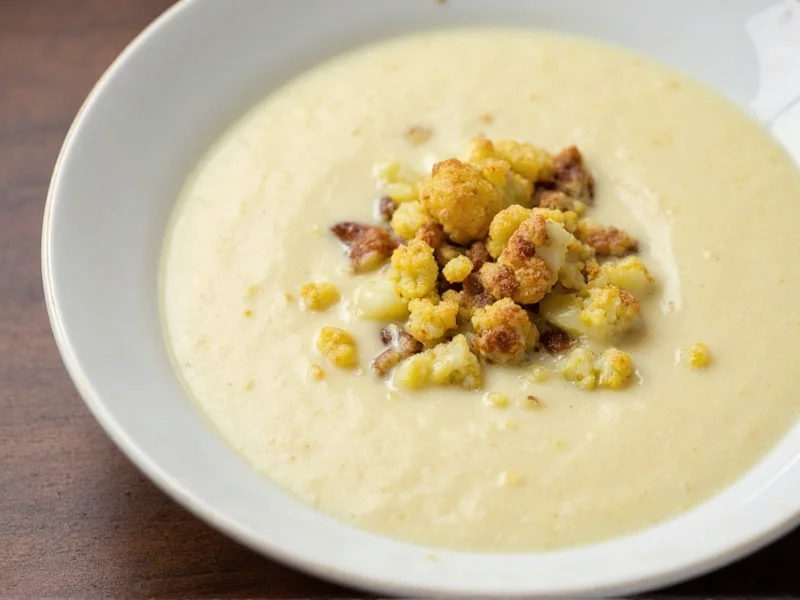Cream of cauliflower soup has gained popularity as a versatile, nutrient-dense alternative to traditional cream-based soups. This simple yet sophisticated dish transforms humble cauliflower into a luxurious culinary experience through careful preparation techniques that preserve both flavor and nutritional value. Unlike many creamy soups, properly prepared cauliflower soup maintains an impressive vitamin C and K profile while delivering just 150-200 calories per serving.
The Essential Components of Perfect Cauliflower Soup
Creating exceptional cream of cauliflower soup begins with understanding its foundational elements. The vegetable itself contains natural thickening properties when cooked properly, reducing the need for excessive cream or roux. For an easy cream of cauliflower soup recipe that delivers restaurant-quality results, focus on three critical components:
| Component | Function | Quality Indicators |
|---|---|---|
| Cauliflower | Primary flavor and texture base | Firm, compact head with no brown spots |
| Aromatics | Flavor foundation | Fresh onions, garlic, leeks without sprouting |
| Liquid Base | Consistency control | Homemade broth preferred over store-bought |
Step-by-Step Preparation Guide
Follow this professional technique for how to make creamy cauliflower soup from scratch with optimal texture and flavor development:
- Sweat aromatics - Cook diced onions and garlic in olive oil over medium-low heat until translucent (8-10 minutes). Avoid browning to maintain delicate flavor.
- Steam cauliflower - Add cauliflower florets and 1/4 cup broth to the pot. Cover and steam for 12-15 minutes until fork-tender but not waterlogged.
- Build flavor - Gradually incorporate remaining broth while scraping browned bits from the pot bottom.
- Blend carefully - Use an immersion blender to achieve smooth consistency without incorporating excess air.
- Finish with cream - Stir in dairy or alternative at the end to prevent curdling and preserve texture.
Dietary Adaptations and Variations
Modern dairy-free cream of cauliflower soup preparations maintain richness through strategic substitutions. For vegan versions, replace cream with:
- Cashew cream (soaked raw cashews blended with water)
- Coconut milk (use light version to avoid overpowering flavor)
- White bean puree (adds protein without altering taste)
Many home cooks seek cauliflower soup without heavy cream for health reasons. The secret lies in maximizing the vegetable's natural starch content through proper steaming technique rather than boiling, which dilutes flavor and nutrients. Roasting cauliflower first creates deeper flavor complexity for those preferring cauliflower soup with cheese variations—try adding sharp cheddar during the blending stage for a sophisticated twist.
Common Texture Problems and Solutions
Even experienced cooks encounter cauliflower soup texture problems. The most frequent issues include:
- Grainy consistency - Caused by undercooked cauliflower or insufficient blending. Solution: Steam longer and use high-powered blender in short bursts.
- Watery texture - Results from over-boiling. Fix: Simmer uncovered to reduce liquid or add small potato for natural thickening.
- Separation - Occurs when dairy is added to boiling soup. Prevent by tempering cream with hot broth before incorporation.
Storage and Reheating Best Practices
Understanding proper cauliflower soup storage tips extends enjoyment of your preparation. Store in airtight containers for:
- Refrigeration: 4-5 days at or below 40°F (4°C)
- Freezing: Up to 3 months in portion-sized containers
When reheating, add small amounts of broth or water to restore ideal consistency. Never boil after adding dairy components. For meal preppers seeking healthy cream of cauliflower soup recipe options, this soup freezes exceptionally well without texture degradation.
Nutritional Benefits Beyond Basic Soup
This cauliflower soup for weight loss favorite delivers impressive nutritional advantages. One serving typically contains:
- 70% of daily vitamin C needs
- Significant fiber content (5g per serving)
- Nearly 100% of vitamin K requirement
- Only 5g of natural sugars
Unlike cream-based soups using roux, properly prepared cauliflower soup achieves creaminess through vegetable puree rather than added fats, making it suitable for multiple dietary approaches including low-carb, gluten-free, and dairy-free eating plans.
Frequently Asked Questions
Can I make cream of cauliflower soup without potatoes?
Yes, you can create excellent cream of cauliflower soup without potatoes. While some recipes include potatoes for additional thickness, cauliflower naturally contains enough starch to achieve creamy texture when properly steamed and blended. For optimal results without potatoes, use the steaming method rather than boiling to concentrate flavors and maintain natural thickening properties.
How do I prevent my cauliflower soup from becoming grainy?
Prevent grainy texture by ensuring complete cooking of cauliflower florets before blending. Steam rather than boil the cauliflower to avoid water absorption that dilutes flavor. Use a high-powered blender in short bursts rather than continuous blending, and strain through a fine-mesh sieve if necessary. The key is proper steaming time—12-15 minutes until very tender but not disintegrated.
What's the best way to reheat frozen cauliflower soup?
Thaw frozen cauliflower soup overnight in the refrigerator before reheating. Gently warm over medium-low heat, stirring frequently. If the soup has separated, use an immersion blender briefly to restore smooth texture. Add small amounts of broth or water as needed to achieve desired consistency, as freezing can sometimes cause slight thickening. Never boil the soup after adding dairy components to prevent curdling.
Can I use frozen cauliflower for cream of cauliflower soup?
Yes, frozen cauliflower works well for cream of cauliflower soup, though fresh produces superior flavor. When using frozen cauliflower, skip the steaming step and add it directly to the sautéed aromatics with broth. Cook until completely tender (15-18 minutes), then proceed with blending. Note that frozen cauliflower contains more moisture, so you may need to reduce added liquid by 25% and simmer longer to achieve proper thickness.











 浙公网安备
33010002000092号
浙公网安备
33010002000092号 浙B2-20120091-4
浙B2-20120091-4